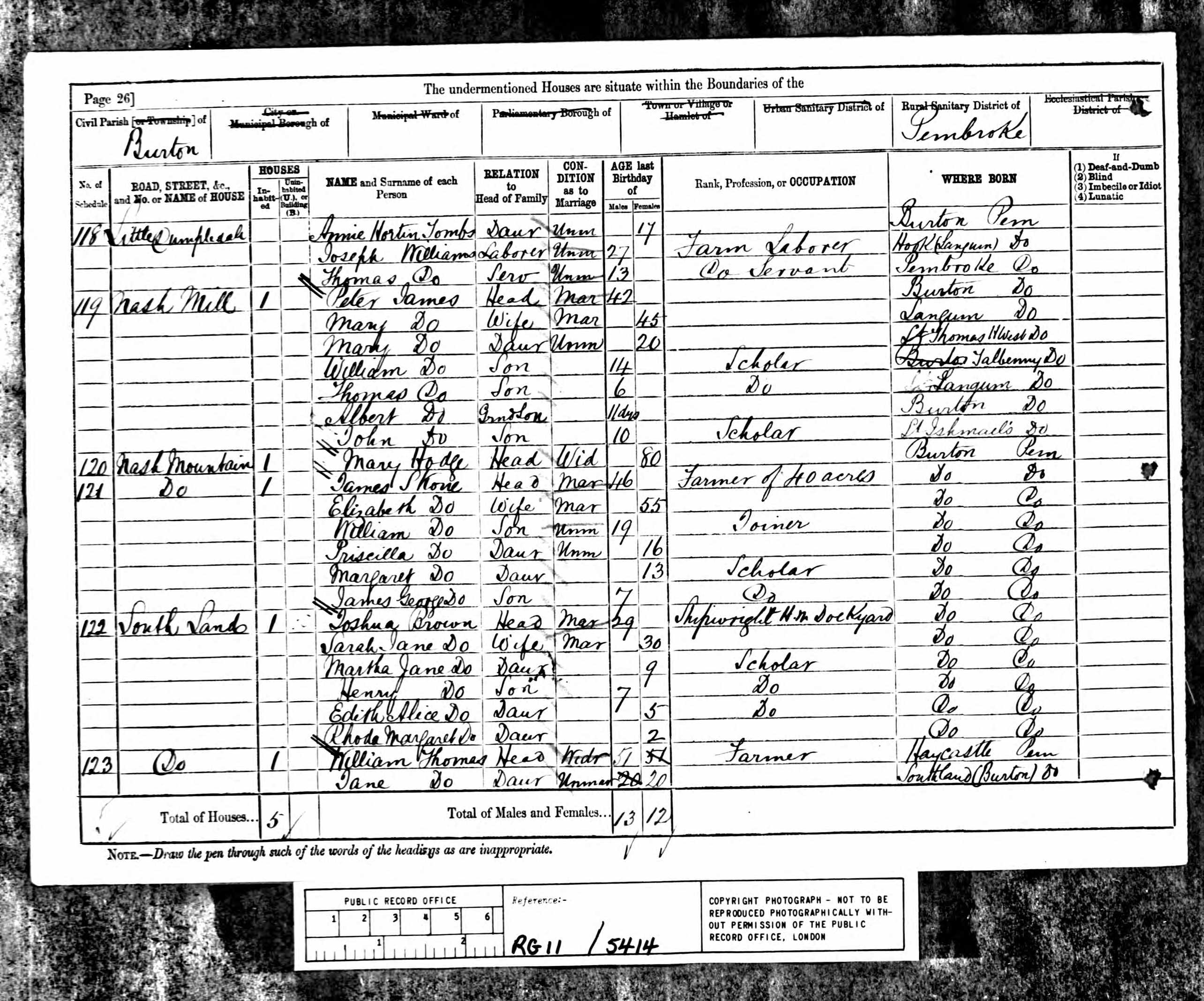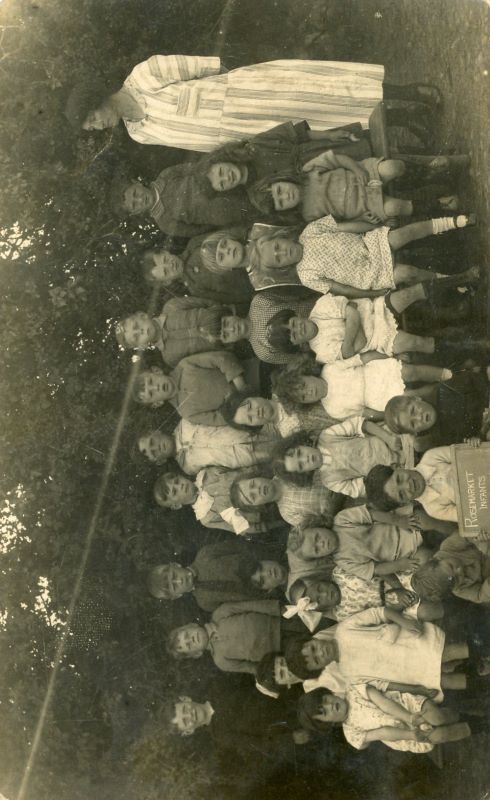Mrs Rhoda Davies was a teacher at Rosemarket School for over 40 years, through two World Wars. Working across a range of sources, including with members of her family locally and across the world, Rosemarket Local History Society is proud to tell her story.
Rhoda was born Rhoda Margaret Brown in 1879 in Burton (a village a few miles from Rosemarket). The 1881 Wales Census shows Rhoda as the youngest of four children to Joshua and Sarah Jane Brown. Her father was listed as “shipwright in the dockyard” whilst her mother took care of the house and children.
 1881 Wales Census listing Rhoda and her family
1881 Wales Census listing Rhoda and her family
The family lived in Hill Mountain, within the Parish of Burton, with relatives living in the surrounding villages, including Rosemarket. It is believed that the children attended Rosemarket School at some point, with Rhoda then taking up the post of Assistant/Supplementary Teacher in 1905.
A war bride…. and widow
On 4th March 1917, Rhoda married John Davies in St Ismael’s church, Rosemarket.
To celebrate the occasion, bride and groom gave the pupils a special wedding tea at the school on the 19th March, noted in the school Logbook. Soon afterwards, John Davies left for France.
 Church marriage register showing Rhoda and John's marriage, 4th March 1917
Church marriage register showing Rhoda and John's marriage, 4th March 1917
Sadly, just over a year later, the school Logbook (17th June 1918) noted Rhoda’s absence “ill owing to nervous collapse on the news of her husband’s death”. Two days later, on 19th June, the Logbook recorded that Rhoda had been granted a Medical Certificate for six weeks’ absence.
John Davies’ military service
The West Wales Memorial Project has kindly granted us permission to use their research on John’s military record, from which the following is re-produced: John was born at Haverfordwest in 1882, the son of John Davies and Ann Davies. He trained as a monumental mason, before moving with his widowed mother to 10 Rock Street, Mountain Ash, where he ran his own business. John enlisted at Mountain Ash into the South Wales Borderers, with the Regimental Number 30486. He later transferred into the 1/28th Battalion (Artists Rifles), London Regiment, which was attached to 190 Brigade, 63rd (Royal Naval) Division.
The division saw its first major action during the Second Battle of Passchendale in October 1917, where heavy casualties were suffered during terrible conditions. The division was then transferred to the Arras sector and took part in the Battle of Cambrai, seeing especially heavy fighting during the Action of Welsh Ridge. The division was still in the area when the Germans launched their Spring Offensive on 21st March 1918 and took part in a gallant rear-guard action as the line was driven back by the Germans. The Germans then switched their attention away to the Lys Valley on 9th April and the sector held by the Royal Naval Division at the Northern edge of the Somme sector quietened down. John was killed in action whilst the Artist’s Rifles were holding a section of the line in Aveluy Wood on 1st June 1918. He is buried in Varennes Military Cemetery, France.
Rhoda’s tributes to her husband
John Davies is not included on the memorial plaque to fallen soldiers in St Ismael’s Church in Rosemarket. This is believed to be because they had lived at Hill Mountain rather than Rosemarket at the time. However, several references to John can be found inside the church.
Rhoda donated a brass book stand in memory of her husband. This is located with prominence at the front of the church and holds the following inscription:
In loving memory of my dear husband
John Davies
The Shop, Hill Mountain
Fell in action June 1st 1918
Interred Varennes British Cemetery France June 2nd
Rhoda Davies

Brass book stand in memory of John Davies
Rhoda also donated a bible, inscribed on the inside front cover in memory of her husband:
In Loving Memory of My Dear Husband, John Davies. The Shop, Hill Mountain. Fell In Action. June 1st 1918. Interred British Cemetery, Varennes, France, June 2nd. Rhoda Davies.

Bible donated to St Ismael's Church by Rhoda Davies
The official ‘Gifts to St Ismael Church’ document also lists the following:
Entry no. 49;
Plain brass cross with stepped base, embossed with I H S at the centre of crucifix.
Approximately 52cm high, 23.3cm wide on cross piece base 18cm by 15.5cm.
Stamped in base; Cox Sons, Buckley & Co, London WC
No inscription
Given according to EMB
By Mrs Rhoda Davies in memory of her husband John Davies

Note that I H S is the acronym for the Latin “lesus Hominum Salvator” (Jesus Men’s Savior).
“Given according to EMB” refers to the submission of the item into the official record by Elsie Margaret Barrah.
Rhoda and her pupils
This photo, labelled ‘Rhoda with her infant class, 1920s’ is one of few classroom pictures taken inside Rosemarket School during that period.

A very rare A6 postcard featuring a photo of Rosemarket Infants class also exists and was recently discovered. Unfortunately, the date is obscured in the picture, but it does include the class teacher, who is believed to be Rhoda.

Postcard showing "Rosemarket Infants" (date unknown)
During the 1920s, Rosemarket became a pioneer of the Schools Meals Service. A hot drink most days and a good meal one day a week was provided by the cookery class.
An entry in the school Logbook on 11th June 1925 noted that Rhoda had been approved to be an instructor for the newly created cookery class, which comprised 8 girls. The first cookery lesson was noted as being held on 28th October 1925, with pea soup being made and served for lunch.

Cookery class, Rosemarket School during the 1920s
The Director of Education was so impressed that he arranged for girls from Hook and Llangwm to come to Rosemarket for ‘Domestic Subjects’. In a letter to the vicar he pointed out that this was because Mrs Davies’ work with the Rosemarket girls was “quite exceptional”.

This photo shows Rosemarket School in February 1929. In the back row on the left of the photo is Mr Tom Bowen. There is some debate as to whether the teacher pictured on the right is Rhoda. Whilst there is some likeness to the class photo taken some years earlier, a relative of Rhoda believes she had taken a leave of absence around this time to help her niece, Kathleen Williams with her wedding to Leonard (Len) Griffiths in 1929. (Rhoda raised her niece from birth). Interestingly, Leonard’s family originated from Rosemarket.
A photo taken during this same period shows Rhoda with some of her family.

Rhoda is seated on the left of the photo, with two of her sisters standing behind her. Her niece, Kathleen, is seated on the right.
Rhoda was very close to Kathleen and visited her and Len many times after they moved from Pembrokeshire to Deal in Kent following their marriage. Kathleen visited Pembrokeshire many times too, returning for summer holidays and family occasions.
Driving ambition
One curious fact sourced from the family was that Rhoda was driving a car of her own from as early as the 1920s. Car ownership during this period was unusual so Rhoda would undoubtedly have been noticed driving around Rosemarket.
One family member recalls an Austin 7 and that she drove a relative to Havefordwest Grammar School in it to take his “scholarship examination” on a Saturday in 1935. Another relative recalls the number plate of DDE34, as she gifted the car to her husband around 1959. It was remembered as being in very good condition as it had been kept in a garage and not used for quite some time.
A devotion to duty
During World War Two, Rhoda continued to teach at Rosemarket School, with some of her relatives from Hill Mountain likely to have been in her class with at least two of them having been evacuated to Rosemarket and attended the school during this time.
In 1945, the school Logbook recorded: “At the end of the Christmas terms, Mrs R.M. Davies resigned her post as Infant Mistress after 41 years of service. The Managers placed on record their appreciation of the great service she had rendered to school and village by the high standard of her teaching and her devotion to duty during those years”.
Life after school
Family members recall that Rhoda lived alone in Hill Mountain after her retirement. She and one of her sisters had adjoining bungalows, with her brother-in-law’s bake house between them.
Rhoda died on 3rd January 1960. On the 7thJanuary edition of the Western Telegraph newspaper, there was a brief entry noting as follows:
“DEATH – DAVIES – Mrs R. M. Davies. Brackenhurst, Hill Mountain, near Neyland at South Harrow. Aged 81 years”.
Further research found an obituary was published later that month, also in the Western Telegraph newspaper (21st January 1960):
FUNERAL OF MRS R. M. DAVIES,
Formerly of Hill Mountain
The funeral of Mrs R M Davies, retired teacher, of Brackenhurst, Hill Mountain took place recently at Harrow. A service was held in the Church of St Peter and was conducted by the Rev H Roberts. The committal service and burial took place in Pinner New Cemetery.
The chief mourners were Mr and Mrs Fred Jones, Mr and Mrs Len Griffiths, Mr Colin Rees, Mr John Rees, Mr Michael Griffiths, Mr and Mrs Peter Griffiths. Mr and Mrs E Rees, Cardiff were unable to attend of ill health.
As to a reason why Rhoda was in Harrow (a borough of London) when she died, her family have confirmed that she was visiting her niece (Kathleen Griffiths) for Christmas – something she did nearly every Christmas after her retirement. Probate records further support this, with the location of her death being a private address in Harrow, also naming her niece as executor of her Will.
The high cost associated with transporting a body back to Pembrokeshire from London (via train) is likely why her funeral took place in Harrow and she was buried in nearby Pinner New Cemetery.
Remembering Rhoda
Throughout our research for this article, we have encountered expressions of praise and respect for Rhoda. In addition to the official records of Rosemarket School that noted her “high standard of teaching and devotion of duty”, relatives recall a remarkable woman too. Here are two we have chosen in conclusion to Rhoda’s story:
“…Auntie Rhoda as a forceful interesting woman gently pushing conventions”.
“… she certainly was an intrepid lady, not deterred by distance or weather”.
Rosemarket Local History Society would like to thank everyone who contributed to this article.